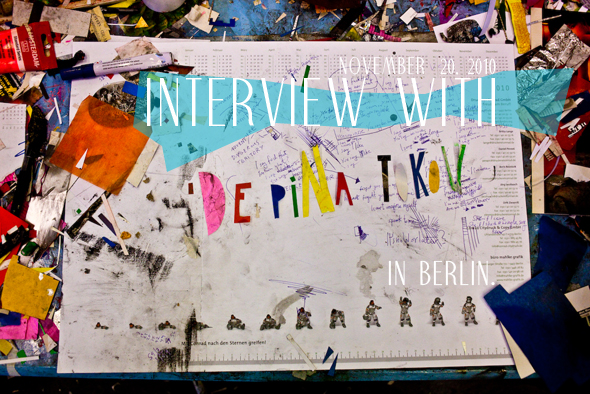by Clare Ros, photos by Mike Milosh // Nov. 26, 2010
Despina Stokou‘s dynamic personality and engaging spirit are reflected equally through her vibrant, colorful canvases, overflowing with strong messages and prodding statements; in addition to her unabashed curatorial approach, unafraid of experimentation. The artist, curator; Artator arrived in Berlin by way of Athens in 2005 to study at the Institute of Art in Context, Universität der Künste on a DAAD (Deutscher Akademischer Austausch Dienst) scholarship. Navigating through Berlin’s creative community, Stokou has left her imprint both artistically and through curatorial endeavors.
A recent shortlist of her Berlin-based involvements include curating Dirty Dozen (D:12), Equinox, and Madonna Psycho Slut at The Grimmuseum, and My Life BarBar at Appartement all in 2010. The Appartement’s exhibition Afterlife Afterhours featured Stokou as a solo artist earlier this year. Stokou’s artwork has also been extensively exhibited by group shows in Berlin, Athens, Amsterdam and Seoul. When the fresh-faced, multitasking art maven is not creating collage works or developing exhibition concepts, she might be found mapping out each season’s contemporary art happenings in advance through the print and web publication, PIGS – the Berlin Independents Guide. This November I caught up with Stokou at her studio in Mitte to discuss her perspectives on art, life and the ever changing face of Berlin.
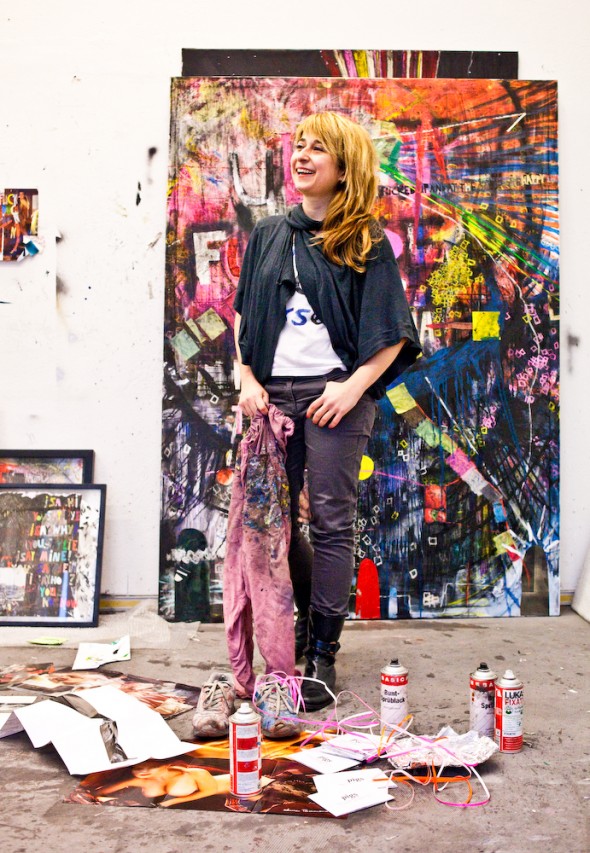
Stokou in her Berlin studio, pictured with the artist’s own paintings, 1970s magazine clippings, and the Pigs publication.
Your work as an artist and curator seem intricately connected. Do you find that your artistic approach influences your curatorial approach, or vice versa, and how so?
Despina Stokou: I don’t know if I even have a curatorial approach or if I can distinguish it from my artistic approach. I am an artist. In everything else I do I apply the same creative strategies I would use in my art. Whether it is curating a show or putting together a guide like Pigs. I actually get a bit offended when people use the word “advertising” for Pigs, I see it as an art project, or maybe it’s a curatorial? See, I am getting confused myself. Truth is, I don’t feel the need to distinguish things, everybody else seems to though. So, ok. I work on my curatorials as I would work my way through a collage or a painting. Starting with only a vague idea or impression of what I want to do and using instinct, intuition, a fair amount of boldness and humor. On the other hand curating and organizing has influenced my artistic work as well. It has structured it in a way. The entire show in Grimmuseum in October was inspired by the theme of the curatorial projects I did this year, whether it was the gender discourse of MadonnA Psycho Slut or the identity discourse of the D12 series. Of course I only initiated these projects because these themes are of immediate importance in my work. So yes I guess it works both ways.
Are there any distinguishing elements that separate both sides of your practice?
DS: I do have to include more people than myself in my curatorial practice so I guess that is the main difference. Hahaha. But no, seriously, you do involve more people, you represent them and you are responsible for their work to be shown in the best possible way individually and as a group. So even if the initial idea and the final decision of what goes where is yours, as in your own artistic practice, it is filtered through the works, reactions and needs of other artists. I find that a very gratifying and refreshing process. I love to paint, I love color, I love the smell of turpentine and I actually need to spend a lot of time alone in the studio otherwise I feel kind of edgy. But let’s face it, being an artist is a very autistic life and I appreciate the opportunity to do things with and for other artists as well.
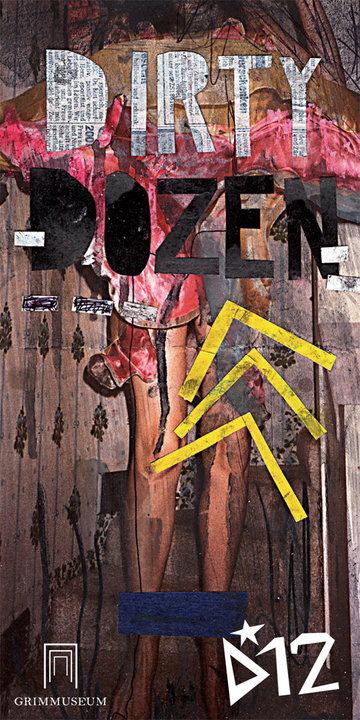
For the Dirty Dozen exhibit, who was your alter ego?
DS: The D12 series had to do with exactly this discourse. Are you an artist or are you a curator? Who are you and then how many of you are there? It seems to be the big thing lately – artists curating. For better? For worse? Any different? I have been trying to launch the word artator (artist-curator), but nobody finds it funny. There is this need for labels in the art (and any) market, but now it is getting really confusing in the era of self-organizing and self-marketing. Artator, Curator, Organizator, Initiator-Potator, Tomator.
For D12 I asked five art professionals (a gallery director, a fellow artist, an art critic, an art editor and a collector) all not primary in the profession of curating to each invent a curatorial alter ego. I was curious how different the creative process of putting together a show would be in each case and how their main profession would influence them in this. And it did, each time. I guess the issue is what constitutes the creative process of curating, and is curating a creative process at all? Making things even more complicated, I had a discussion with Carson Chan (Director of Program) the other day, he feels there is a need to distinguish even further between the process of choosing the artists, the process of organizing a show and the process of putting up a show (which is the actual curating), as three different tasks that should be performed by three different professionals.
How did you become involved with the Grimmuseum?
DS: The initiator of the project Enrico Centonze invited me to curate a few shows. He had seen a previous project of mine, Apply Softly at Preview Art Fair and liked it. About a year later I got a mail from him: “I am the owner of a museum. We need to talk.” The inaugural exhibition in Grimmuseum Madonna Psycho Slut was also the first exhibition I ever curated.
How many curators are at the Grimmuseum? To what degree do you collaborate on the exhibitions?
DS: Six artists run the three different programs while Enrico coordinates everything. Andres Galeano runs the Extension Series – on performance art and its documentation. Francesco Cavaliere & Marcel Türkowsky created the Whistle Minotaure! series on sound art. Silja Leifsdottir, Ina Otzko and myself each curated one or more shows this year. We all come from very different backgrounds and genres. There has been some thought of all collaborating in one show, we just have not got down to it yet.
Do you have favorite artists in Berlin?
DS: I admire Kirstine Roepstorff from afar for her work, personality and lifestyle. I admire Iris Van Dongen for the same reasons, from a bit closer up.
What do you consider essential elements to curate a successful exhibition?
DS: Money, humor, ambition.
Reflecting upon the last 12 months, what curatorial lessons have you learned?
DS: Don’t invite friends to a show just because they are friends. Ask for a number of proposals you can choose from (so you can avoid studio visits). Don’t accept “help” from participating artists when putting up a show. Leave time and budget for the lighting.
Do you consider yourself a risk-taker?
DS: Risk is a silly word, it implies fear- and of course this is what it all gets down to. Seriously, if I still have any romantic notion about the role of the artist in society it is the mission of art to make people feel less helpless- escape the banality of not being able to control one single thing in their lives. The way things work right now this is of course hardly possible, because everybody in the art world feels helpless too. Artists who don’t sell feel helpless that they don’t, artists who do sell, feel helpless that it can stop at any minute, gallerists feel helpless that they will get dumped by the famous artists, or they will never actually get their money’s worth back. Collectors feel helpless they don’t have enough money for the big shots, they have to keep guessing and may end up accidentally overlooking the next Damien Hirst. So yeah, I think it is important to break a few rules, be bold, be free, try new ways, have fun, get people to have fun.
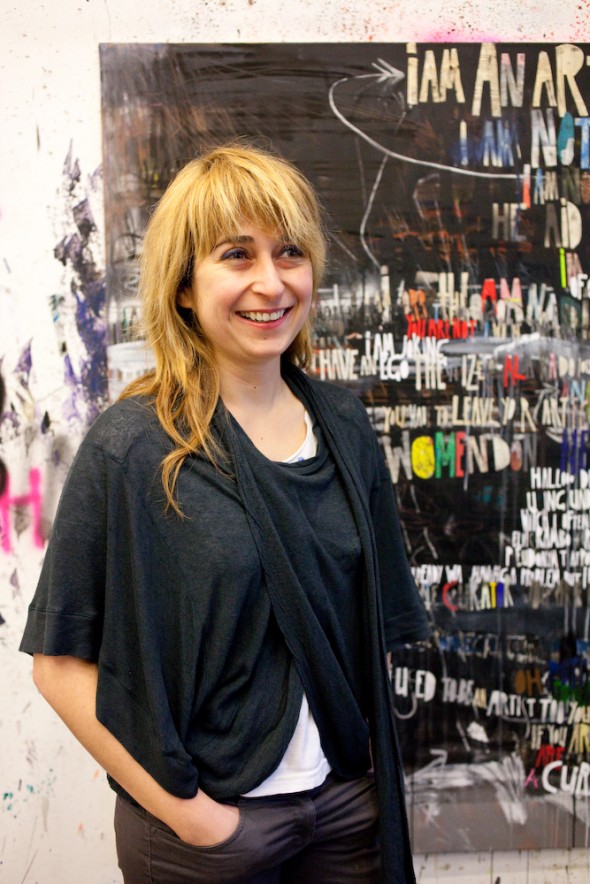
Stokou in front of her painting If you don’t watch out you are going to end up a curator like me, 2010, mixed material on canvas; 120×160 cm
I admire that you have incorporated the notion of chance into the curatorial projects you undertake. In that regard it seems that you structure shows as an artwork that toys with the experimental. Do you consider your curatorial work performative?
DS: Yeah I like this chance element in my curatorials- one part of it is self-irony or ironical to the fact of me curating, because I am not a curator, it is very clear to me. It is also questioning the act of curating in general, because let’s face it- we have seen tons of improbable crap called curatorial lines. The other part is a game, a strategy. I start with a (seemingly) random and outrageous curatorial intention like: only-women, or artists-working-in-bars, or men-I-find-sexually-attractive. Then I build up the show through and with the reactions as I go along. It is an act, a role, you are right. Concept, curator-persona and process become part of the show.
You first came to Berlin in 2002, and have since worn many hats as an artist, curator, and community organizer. Over the last eight years, how has the city changed in your mind?
DS: Well, I missed the chance to squat and then get an apartment building in Prenzlauer Berg by 5–10 years; things were still quite messy when I came, a lot of empty spaces, unrenovated facades with bullets, a lot of humid cellar clubs and many, many cranes, I think they were just finishing up Potsdamer Platz. All this has changed of course. I think the Palast der Republik debacle was the last open wound and even there, green grass grew over it now. Maybe the history of the Soho house building is the perfect example of how Berlin has developed. First a Jewish department store, only to be taken over by the Nazi party for their Nazi youth headquarters, to be taken over by the East German Communist Party as their entertainment center post war, to be given back to the Jewish owners families post wall, remain empty and unused for 12 years, to be sold to a British investor and open as a private member Hotel last May. The city grew up, it has buttoned up in many ways and I actually think this is a good thing. I can safely say this of course because I think there will always (or for a very long time) be the unresolved issue of East Berlin to keep things even and the life cost affordable for a lot of artists to live here.
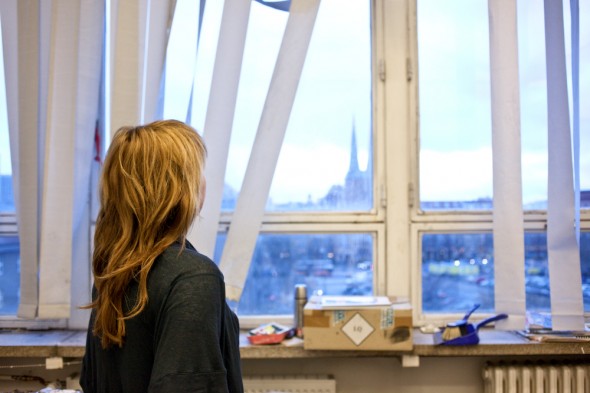
Stokou’s studio view from just south of Alexanderplatz
Which major developments or shifts within the art community have you most noticed or experienced?
DS: Well there was this commercial gallery boom right before the crisis with I don’t know how many new galleries opening, the Heide Strasse area, the Linden street area, the gallery Weekend. Big names started showing up. At some point it seemed as if Berlin would take up its place between the big boys of London, and New York in the art market. This seems to have cooled down. I even read Haunch of Venison is going again. Now there is more of a project space boom, there is a ridiculous amount of project spaces opening in Kreuzköln, seriously! And they seem to be here to stay. I think it is a phenomenon that can actually help the Berlin art scene maintain its healthy balance, if only they would find a way to finance themselves. And then of course at some point, I don’t know who was the first, but Forgotten Bar definitely made it popular—the “one night show”: the art+bar combination, which by the way is a way of financing things, just not enough.
Do you recall your anticipation of what the city held before coming here?
DS: I was not coming to stay, so I did not anticipate anything. Although I went to a German school in Athens and at some point they declared the third of October as a holiday and showed us different maps in geography, I never gave the whole East/West Germany a thought or what it meant for Berlin. It was hardly possible but I wish I had come earlier. I wish I had experienced Kreuzberg during the Wall time. Met Kippenberger. But anyway, even when I did come it was quite clear that this is a city so messed up, with so many things to work through towards normal (western normality) that one is free to do whatever one wants. This was the anticipation with which I decided to stay and I was not disappointed.
What advice would you give to newcomers to Berlin?
DS: Learn German or you will never be really accepted. Unless you are American, in that case, don’t bother, you’ll never get the accent right.
As someone actively dedicated to a number of projects, how do you divide your time?
DS: 5 hours online time – 5 hours studio time – 5 hours bar time.
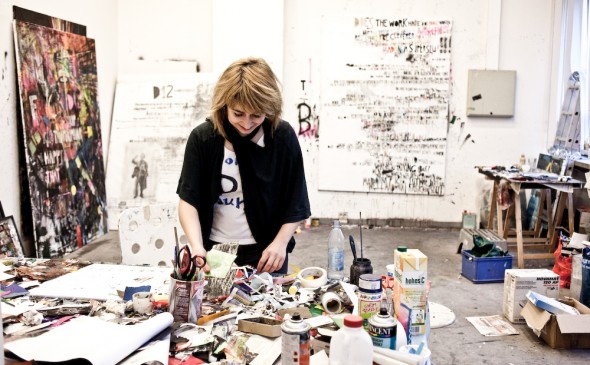
Stokou in her studio surrounded by works from the D12 exhibit, and works in progress at her desk
I have read about your obsession with color, is there a particular hue you are drawn to?
DS: If I had to choose it would be Cerulean blue. This hue is awesome- the only one I use unmixed all the time. It is the color of a sunny sky with thick white clouds.
Are there any that repulse you (when used in art or that appear in life)?
DS: I hate green, I just hate it! Especially Tannenbaum green. Grass green is kind of ok. Turquoise on the other hand is a different story. I have never bought a tube of green color or green piece of clothing. I don’t mind green eyes.
What color (or combination) would you use to describe yourself?
DS: Yellow and neon pink. That’s my bag on my bike.
As an artist that deals with text, do you have a preferential font?
DS: Haha…I am not friends with Word so I keep it simple. I used Arial and Arial black for Apply Softly. Now I do Pigs Tips in Helvetica. Don’t ask me why. A friend suggested I should launch a Stokou font, from the cut out letters I use…
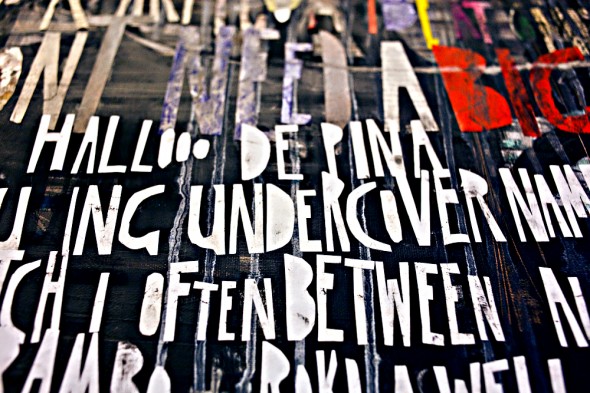
If you don’t watch out you are going to end up a curator like me, 2010, detail view, mixed material on canvas; 120x160cm
How many hours do you spend cutting out letters?
DS: I would need good 15-20 days to transfer this interview. At some point I stopped cutting out the “S”. Because it s such a tricky form you have to turn the scissors five times to get it, and it’s never to my satisfaction. So now I just skip it. Maybe others will follow. “E” also takes a lot of time.
When you’re not working with collage, are there other mediums with which you experiment?
DS: I write my own texts so I guess I am experimenting with poetry and writing too. I would love to write the lyrics for a song at some point. Not as much as I would like a song to be written about me, but still. Imagine, one single hit and you are in the minds (and in the showers) of millions of people for generations.
When you’re not curating, or developing your own projects, what might we find you doing?
DS: In the park jogging next to Sebastiaan Schlicher reenacting Rocky.


